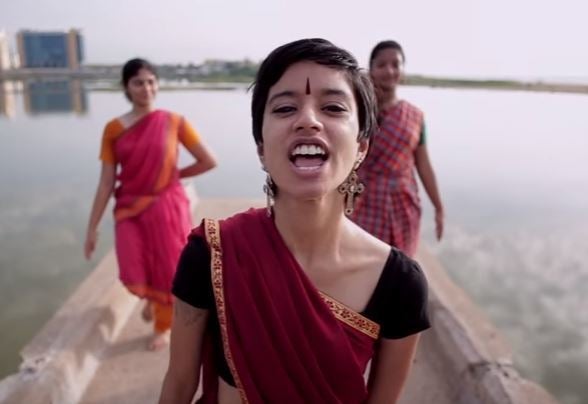
A still from a viral parody music video pressuring Unilever to pay compensation to 591 victims of mercury poisoning.
By Koketso Moeti
Braving below zero temperatures this winter in Ottawa Canada, activists descended on the headquarters of Shopify, an ecommerce platform, to deliver a 200,000 strong petition. The petition, organised by SumOfUs, a consumer watch-dog, together with Sleeping Giants, an anonymous group of activists, calls on shopify to stop supporting sales of merchandise produced by the extreme right-wing U.S. news site Breitbart.
This was just the latest move in a successful campaign launched last year that aims to pressure companies to pull their advertisements from the Breitbart site. Using social media, Sleeping Giants asked people to take screenshots of the ads and then email or tweet the company involved to make them aware they are tacitly endorsing and financing right wing propaganda. So far more than 1,400 companies have heeded the call, including Nordstrom, Warby Parker and Mercedes-Benz. Now the campaign has Shopify in its sights.
These actions are a timely reminder that although new technologies can reinforce existing inequalities (because those with more power often have the best access) they can also help us fight back. Across the globe the web and mobile technology have offered creative ways to organise, share information and mobilise people for collective action.
The power of going viral
In Kondaikanal, India, hundreds of workers were affected by mercury exposure at what used to be the Hindustan Unilever thermometer factory. Jhatkaa, a non-partisan group that uses digital technology to mobilise Indian citizens to hold decision makers accountable, decided to take on Unilever—a corporation worth billions. A breakthrough came in March 2016 following the release of a parody music video which went viral, receiving almost four million views and even a tweet from Nicki Minaj. The video was part of a solidarity campaign supported by over 90, 000 people. Suddenly the struggle of a small forgotten community of some 600 workers was amplified and supported by tens of thousands. Unilever finally agreed to pay compensation to 591 victims of mercury poisoning on “humanitarian grounds”.
Jhatkaa isn’t the only organisation using opportunities of the digital space to fight for a more just world. In the United States we have seen groups such as Color of Change, Black Lives Matter and Dream Defenders use mobile and web technology as a means of counter-speech, to organise events and to document incidents of racial injustice.
In Kenya, technology expert Nanjira wrote about the pervasive practice of having all male panels. That led to the use of the hashtag #SayNoToManelsKE on social media. Together with Ory Okolloh, they put together an open, online database of women speakers to counter the fallacious argument that there aren’t women qualified or willing to show up.
From digital to direct action
Digital action, or “Slactivism” as it’s sometimes called, has its critics. It’s seen as providing all the satisfaction and little of the skin in the game that in-person protest requires. The sketch comedy show Portlandia recently skewered the practice, invoking the notion that slactivists fail to practice what they preach. Those that dismiss the use of digital tools as a means of organising often do so by invoking the false distinction between ‘real’ activists and ‘online’ activists, what Malcolm Gladwell in 2010 called ‘small change’.
And yet, my own experience at amandla.mobi also points to the power of digital activism. During the protests against the cost of tuition at South Africa’s higher education institutions under the banner ‘Fees Must Fall,’ some of our members wanted to show solidarity with the students but were unable to join them on the streets. So at amandla.mobi we enabled our members to support in other ways. When universities cut off their Wi-Fi, we were able to provide data to protesting students that allowed them to continue to broadcast what was happening at their campuses. The money raised also paid for meals, allowed injured students to get medical care, or to pay for their bail.
What happens in the digital space can and does have a real world impact. Despite being from different countries and working on different issues, all the examples cited above used technology to mount effective campaigns that moved beyond short term viral sensations in the digital space to have sustained impact in the public sphere.
In her TED talk , social commentator Sisonke Msimang describes how stories and news - as important as they are - are often not enough to push people into taking action. Knowing about injustice is often not enough to persuade people to do anything about it. But building engagement in the digital space acts as a springboard to motivate and enable people to take more direct action.
The growth of digital activism should not be seen as the antithesis of traditional modes of organising, but rather as a means of enabling and supplementing offline actions, a creative way of bringing people together to take collective action on issues that matter. We should be embracing the power of new technologies and using them for the greater good.
Koketso Moeti is founder of amandla.mobi and an Aspen New Voices Fellow. Follow her on Twitter @kmoeti.
